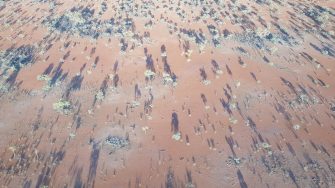
Date: Friday, October 5, 2018
Project: Eastern Australian Waterbird Survey
Observers: Richard Kingsford
A daybreak start was a must before the heat hit which it eventually did, but at least we got some early flying in. Out of Mt Isa, then south 200km and then east to eventually reach Rockhampton - always our longest day of aerial survey.
Our early morning was stunning, as the sun rose in the east and turned everything a golden brown and cast long shadows across the landscape.
Our first survey was down on the Georgina River, at Lake Katherine, a deep series of narrow waterholes. They always have water and sometimes lots of waterbirds. The water levels seemed much lower than I had expected, potentially they missed the flood earlier in the year. There were cormorants, pelicans and hardhead – not many more than a hundred in total.
From here it was a long haul over dry river beds and the odd farm dam, until we hit the floodplains of the Diamantina River just west of Winton. Here there was a little water still in the channels from the flood early in the year - when the floods come down this part of the floodplain, they don’t stay long, moving their way south. We flew the Western River flows past the town of Winton, a tributary of the Diamantina but it was bone dry.
A quick bite to eat and then off on the long leg to Rockhampton. The first part is just a series of small farm dams, most of them dry because of the drought. The few that had a little water often had five or ten waterbirds, another reflection of the dry period, along with livestock. Any water anywhere is used by waterbirds.
The waterholes and tributaries of the Thomson River also still had some water after flooding earlier in the year.
Our only bit of serious surveying happened when we got to Lake Dunn, a small freshwater lake north of Aramac. It had a few hundred waterbirds, mostly grey teal and a variety of species, including a small flock of brolgas. The much bigger salt, Lake Galilee to the north, was dry. This is one of the more special wetlands we survey when it has water, with tens of thousands of waterbirds.
After this, we picked up small farm dams all the way until we were north of Rockhampton. Once we flew over the coal fields, it was cropping areas on the other side. Flocks of brolgas in their hundreds were standing around the small dams across this agricultural area. It is a treat to see such large concentrations. Tomorrow is a compulsory rest day for our pilot before we head west again.
